High Energy Astronomy Observatory
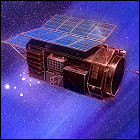 NASA launches the first High Energy Astronomy Observatory satellite in Earth orbit, continuing the survey of the sky with sensitive detectors designed to find gamma ray and X-ray sources. HEAO-1 will remain in service through January 1979, and will re-enter Earth’s atmosphere in March 1979.
NASA launches the first High Energy Astronomy Observatory satellite in Earth orbit, continuing the survey of the sky with sensitive detectors designed to find gamma ray and X-ray sources. HEAO-1 will remain in service through January 1979, and will re-enter Earth’s atmosphere in March 1979.
The Rings of Uranus
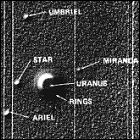 A team of MIT astronomers, flying in a plane modified to serve as an airborne high-altitude telescope, plans to observe the planet Uranus as it eclipses, or “occults”, a star. But the team observes more occultations than expected both before and after the planet itself passes in front of the star. The inevitable conclusion is that Uranus has rings, made of material too dark to be detected by existing Earthbound telescopes. Further observations are given top priority: NASA’s Voyager 2 space probe, due to lift off later in 1977, may last long enough to reach Uranus, and the newly discovered rings must be taken into account when planning its flyby trajectory.
A team of MIT astronomers, flying in a plane modified to serve as an airborne high-altitude telescope, plans to observe the planet Uranus as it eclipses, or “occults”, a star. But the team observes more occultations than expected both before and after the planet itself passes in front of the star. The inevitable conclusion is that Uranus has rings, made of material too dark to be detected by existing Earthbound telescopes. Further observations are given top priority: NASA’s Voyager 2 space probe, due to lift off later in 1977, may last long enough to reach Uranus, and the newly discovered rings must be taken into account when planning its flyby trajectory.
Themisto
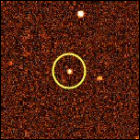 Astronomers catch fleeting glimpses of a new natural satellite of Jupiter, Themisto, though the initial estimates of its orbit are “off” enough that Themisto becomes “lost” and isn’t observed again until 2000. With a diameter of roughly five miles, Themisto marks the dividing line between the larger inner moons of Jupiter and the widely-scattered menagerie of asteroid-like outer moons orbiting the planet. Astronomers Elizabeth Roemer and Charles Kowal (who discovered another new Jovian moon in 1974) share credit for discovering the moon. Themisto is the last Jovian satellite to be discovered by ground-based telescope in the 20th century.
Astronomers catch fleeting glimpses of a new natural satellite of Jupiter, Themisto, though the initial estimates of its orbit are “off” enough that Themisto becomes “lost” and isn’t observed again until 2000. With a diameter of roughly five miles, Themisto marks the dividing line between the larger inner moons of Jupiter and the widely-scattered menagerie of asteroid-like outer moons orbiting the planet. Astronomers Elizabeth Roemer and Charles Kowal (who discovered another new Jovian moon in 1974) share credit for discovering the moon. Themisto is the last Jovian satellite to be discovered by ground-based telescope in the 20th century.
SAS-C
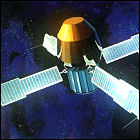 NASA launches Explorer 53, renamed Small Astronomy Satellite C, from an Italian-owned offshore launch platform off the coast of Kenya. SAS-C is a smaller spacecraft than NASA’s larger Orbiting Astronomical Observatory (OAO) series, but can be aimed very precisely at any cosmic X-ray sources that it detects. One of SAS-C’s discoveries is MXB1730-33, a binary star giving off rapid X-ray bursts. SAS-C will remain in orbit and functional until it re-enters Earth’s atmosphere in 1979.
NASA launches Explorer 53, renamed Small Astronomy Satellite C, from an Italian-owned offshore launch platform off the coast of Kenya. SAS-C is a smaller spacecraft than NASA’s larger Orbiting Astronomical Observatory (OAO) series, but can be aimed very precisely at any cosmic X-ray sources that it detects. One of SAS-C’s discoveries is MXB1730-33, a binary star giving off rapid X-ray bursts. SAS-C will remain in orbit and functional until it re-enters Earth’s atmosphere in 1979.
You’re listening to Earth FM
 The first transmission from Earth designed to be a message for interstellar listeners is broadcast from the newly-refurbished Arecibo Radio Telescope in Puerto Rico. Weighing in at 210 bytes, the message is a binary transmission that, when properly assembled, provides a graphical representation of Earth’s solar system, a human being, the makeup of human DNA and the elements from which it is constructed, and the population of Earth. Though the Arecibo dish is pointed in the direction of the M13 globular cluster at the time of the message’s transmission, that cluster will have moved in the 25,000 years it takes for the message to reach that location (and, in any case, Earth and its entire solar system will have moved in the 25,000 additional years it would take to receive a reply), so the message is more of an interstellar technology demo than a message in a bottle.
The first transmission from Earth designed to be a message for interstellar listeners is broadcast from the newly-refurbished Arecibo Radio Telescope in Puerto Rico. Weighing in at 210 bytes, the message is a binary transmission that, when properly assembled, provides a graphical representation of Earth’s solar system, a human being, the makeup of human DNA and the elements from which it is constructed, and the population of Earth. Though the Arecibo dish is pointed in the direction of the M13 globular cluster at the time of the message’s transmission, that cluster will have moved in the 25,000 years it takes for the message to reach that location (and, in any case, Earth and its entire solar system will have moved in the 25,000 additional years it would take to receive a reply), so the message is more of an interstellar technology demo than a message in a bottle.
Leda
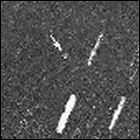 Astronomer Charles Kowal discovers Leda, a tiny, previously undiscovered moon of Jupiter, using Mount Palomar Observatory’s telescope. With a radius of less than seven miles and an inclined orbit, Leda is the first Jovian moon discovered in over two decades, and is among the last to be discovered using ground-based telescopes in the 20th century.
Astronomer Charles Kowal discovers Leda, a tiny, previously undiscovered moon of Jupiter, using Mount Palomar Observatory’s telescope. With a radius of less than seven miles and an inclined orbit, Leda is the first Jovian moon discovered in over two decades, and is among the last to be discovered using ground-based telescopes in the 20th century.
SAS-B
 NASA launches Explorer 48, renamed Small Astronomy Satellite B, from an Italian-owned offshore launch platform off the coast of Kenya. SAS-B is a smaller spacecraft than NASA’s larger Orbiting Astronomical Observatory (OAO) series, but can be aimed very precisely at any gamma ray sources that it detects. One of those sources turns out to be the pulsar remnant of a massive supernova, a discovery later named Geminga. An electrical fault will end SAS-B’s functionality in June 1973, and it will re-enter Earth’s atmosphere in 1976.
NASA launches Explorer 48, renamed Small Astronomy Satellite B, from an Italian-owned offshore launch platform off the coast of Kenya. SAS-B is a smaller spacecraft than NASA’s larger Orbiting Astronomical Observatory (OAO) series, but can be aimed very precisely at any gamma ray sources that it detects. One of those sources turns out to be the pulsar remnant of a massive supernova, a discovery later named Geminga. An electrical fault will end SAS-B’s functionality in June 1973, and it will re-enter Earth’s atmosphere in 1976.
Orbiting Astronomical Observatory 3: Copernicus
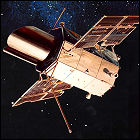 NASA launches the third and final Orbiting Astronomical Observatory satellite, given the nickname “Copernicus” when it successfully enters service near the 500th anniversary of the birth of the famed astronomer of the same name. OAO-3 is a joint venture between NASA and universities in the U.S. and the U.K., again focusing largely on ultraviolet observation of the sky, and it is instrumental in the discovery and study of long-period pulsars. OAO-3 will remain in service through February 1981, its successful nine-year mission lending weight to the ongoing construction and planning of NASA’s Space Telescope project, later to be known as the Hubble Space Telescope.
NASA launches the third and final Orbiting Astronomical Observatory satellite, given the nickname “Copernicus” when it successfully enters service near the 500th anniversary of the birth of the famed astronomer of the same name. OAO-3 is a joint venture between NASA and universities in the U.S. and the U.K., again focusing largely on ultraviolet observation of the sky, and it is instrumental in the discovery and study of long-period pulsars. OAO-3 will remain in service through February 1981, its successful nine-year mission lending weight to the ongoing construction and planning of NASA’s Space Telescope project, later to be known as the Hubble Space Telescope.
A near miss: the Great 1972 Fireball
 In the broad daylight of mid-afternoon, an asteroid measuring somewhere between 10 and 50 feet in diameter plows through Earth’s atmosphere over North America, creating a long-tailed fireball across the sky. Undetected before its close pass – only 35 miles from Earth’s surface – asteroid US19720810 skips off of the atmosphere and back into space, having lost half of its mass to the frictional heating of plummeting through the atmosphere. The spectacle lasts only a couple of minutes, and US19720810 will make another pass by the Earth in 1997 (though not at such a close distance).
In the broad daylight of mid-afternoon, an asteroid measuring somewhere between 10 and 50 feet in diameter plows through Earth’s atmosphere over North America, creating a long-tailed fireball across the sky. Undetected before its close pass – only 35 miles from Earth’s surface – asteroid US19720810 skips off of the atmosphere and back into space, having lost half of its mass to the frictional heating of plummeting through the atmosphere. The spectacle lasts only a couple of minutes, and US19720810 will make another pass by the Earth in 1997 (though not at such a close distance).
Orbiting Astronomical Observatory 2: The Stargazer
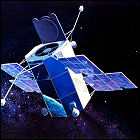 NASA launches the second Orbiting Astronomical Observatory satellite, given the nickname “Stargazer” after it successfully enters service. OAO-2 will remain in service for over four years, making significant contributions to the scientific understanding of comets and supernovae. Two separate experiments, including one designed and overseen by Dr. Fred Whipple, observe the sky in ultraviolet light from Earth orbit.
NASA launches the second Orbiting Astronomical Observatory satellite, given the nickname “Stargazer” after it successfully enters service. OAO-2 will remain in service for over four years, making significant contributions to the scientific understanding of comets and supernovae. Two separate experiments, including one designed and overseen by Dr. Fred Whipple, observe the sky in ultraviolet light from Earth orbit.
Arecibo and the Crab Nebula Pulsar
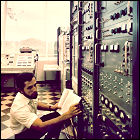 Cornell University student Richard Lovelace, working at the Cornell-funded Arecibo Radio Telescope in Puerto Rico, uses the massive telescope and its on-site computers to determine the rotational period of a pulsar discovered near the center of the Crab Nebula, approximately 6,500 light years from Earth. The position of the pulsar relative to the nebula strengthens the case for pulsars and (still hypothetical) neutron stars occurring at the heart of supernova remnants. The Crab Nebula pulsar had been discovered only three years earlier.
Cornell University student Richard Lovelace, working at the Cornell-funded Arecibo Radio Telescope in Puerto Rico, uses the massive telescope and its on-site computers to determine the rotational period of a pulsar discovered near the center of the Crab Nebula, approximately 6,500 light years from Earth. The position of the pulsar relative to the nebula strengthens the case for pulsars and (still hypothetical) neutron stars occurring at the heart of supernova remnants. The Crab Nebula pulsar had been discovered only three years earlier.
Epimetheus
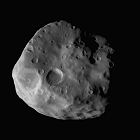 Just days after the discovery of a satellite in a near-identical orbit, U.S. Naval Observatory astronomer Richard Walker discovers Epimetheus, another natural satellite of the planet Saturn, again orbiting just beyond the outer edge of Saturn’s ring. Many of Walker’s fellow astronomers believe this is merely a second sighting of Janus, discovered mere days before, but irregularities in the computed orbits vex astronomers well into the 1970s, at which point it is conceded that the observations are best explained by two satellites in a very close orbit to one another. Epimetheus and Janus will next be spotted by Voyager 1 in 1980, conclusively proving the existence of two bodies. Epimetheus’ name won’t be made official until 1983. (Epimetheus is shown here in a 21st century Cassini photo.)
Just days after the discovery of a satellite in a near-identical orbit, U.S. Naval Observatory astronomer Richard Walker discovers Epimetheus, another natural satellite of the planet Saturn, again orbiting just beyond the outer edge of Saturn’s ring. Many of Walker’s fellow astronomers believe this is merely a second sighting of Janus, discovered mere days before, but irregularities in the computed orbits vex astronomers well into the 1970s, at which point it is conceded that the observations are best explained by two satellites in a very close orbit to one another. Epimetheus and Janus will next be spotted by Voyager 1 in 1980, conclusively proving the existence of two bodies. Epimetheus’ name won’t be made official until 1983. (Epimetheus is shown here in a 21st century Cassini photo.)
Janus
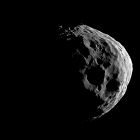 French astronomer Audouin Dollfus discovers Janus, the tenth discovered natural satellite of the planet Saturn, orbiting just beyond the outer edge of Saturn’s ring. Confusion is caused when, mere days later, an American astronomer discovers another body in a near-identical orbit that cannot be reconciled with the orbit calculated for Janus. Only in the late 1970s will a theory emerge that explains the inconsistencies as the presence of two moons moving around Saturn as a co-orbital pair, occasionally swapping positions. Janus’ existence will be verified in 1980 by Voyager 1. (Janus is shown here in a 21st century Cassini photo.)
French astronomer Audouin Dollfus discovers Janus, the tenth discovered natural satellite of the planet Saturn, orbiting just beyond the outer edge of Saturn’s ring. Confusion is caused when, mere days later, an American astronomer discovers another body in a near-identical orbit that cannot be reconciled with the orbit calculated for Janus. Only in the late 1970s will a theory emerge that explains the inconsistencies as the presence of two moons moving around Saturn as a co-orbital pair, occasionally swapping positions. Janus’ existence will be verified in 1980 by Voyager 1. (Janus is shown here in a 21st century Cassini photo.)
Orbiting Astronomical Observatory
 NASA launches its first space-based telescope, the unmanned Orbiting Astronomical Observatory satellite, into Earth orbit. Weighing nearly two tons and sporting visible, ultraviolet, X-ray and gamma ray astronomy capabilities, OAO is in trouble mere minutes after it goes into service: a serious electrical failure leaves the spacecraft in a blind tumble, and it will be declared a loss three days after launch. NASA will attempt another OAO launch in 1968.
NASA launches its first space-based telescope, the unmanned Orbiting Astronomical Observatory satellite, into Earth orbit. Weighing nearly two tons and sporting visible, ultraviolet, X-ray and gamma ray astronomy capabilities, OAO is in trouble mere minutes after it goes into service: a serious electrical failure leaves the spacecraft in a blind tumble, and it will be declared a loss three days after launch. NASA will attempt another OAO launch in 1968.
Echoes of the Big Bang
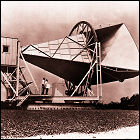 Using a 20-foot, horn-shaped receiver built at Bell Laboratories’ Holmdell, New Jersey facility for tests of the Echo-1 satellite in 1960, radio astronomers Arno Penzias and Robert Wilson stumble across the first sign of the Cosmic Microwave Background: a microwave signal indicating a 2.7 Kelvin background radiation emanating from every point in the universe, which Wilson and Penzias believe may be leftover radiation from the birth of the universe (confirming the “Big Bang theory” that had come about when astronomer Edwin Hubble discovered in the 1920s that the Doppler effect indicated that galaxies were moving away from each other). Though this monumental discovery will net the two a Nobel Prize for physics in 1978, Penzias and Wilson initially believe that the radiation is man-made or perhaps the result of pigeon droppings in the antenna interfering with their instruments!
Using a 20-foot, horn-shaped receiver built at Bell Laboratories’ Holmdell, New Jersey facility for tests of the Echo-1 satellite in 1960, radio astronomers Arno Penzias and Robert Wilson stumble across the first sign of the Cosmic Microwave Background: a microwave signal indicating a 2.7 Kelvin background radiation emanating from every point in the universe, which Wilson and Penzias believe may be leftover radiation from the birth of the universe (confirming the “Big Bang theory” that had come about when astronomer Edwin Hubble discovered in the 1920s that the Doppler effect indicated that galaxies were moving away from each other). Though this monumental discovery will net the two a Nobel Prize for physics in 1978, Penzias and Wilson initially believe that the radiation is man-made or perhaps the result of pigeon droppings in the antenna interfering with their instruments!
Mercury’s shorter, but still very long, days
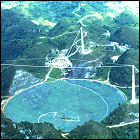 Using the Arecibo Radio Telescope in Puerto Rico, a team of radio astronomers led by Gordon Pettengill makes the determination that Mercury rotates on its axis once every 59 Earth days, a much shorter “day” for Mercury than the previously estimated 88 Earth day rotation. Pettengill is a pioneer of radio and radar astronomy, and will go on to use both methods to study asteroids, Venus, and Earth’s moon.
Using the Arecibo Radio Telescope in Puerto Rico, a team of radio astronomers led by Gordon Pettengill makes the determination that Mercury rotates on its axis once every 59 Earth days, a much shorter “day” for Mercury than the previously estimated 88 Earth day rotation. Pettengill is a pioneer of radio and radar astronomy, and will go on to use both methods to study asteroids, Venus, and Earth’s moon.
Arecibo!
 Nestled into a mountainous forest region of Puerto Rico, the Cornell University-funded Arecibo Radio Telescope officially begins operations. With a diameter of a thousand feet, this remains the world’s largest radio telescope until the 21st century. Studies of Earth’s ionosphere are high on the priority list, but radio astronomy isn’t far behind, and important discoveries are made at Arecibo within months of it opening.
Nestled into a mountainous forest region of Puerto Rico, the Cornell University-funded Arecibo Radio Telescope officially begins operations. With a diameter of a thousand feet, this remains the world’s largest radio telescope until the 21st century. Studies of Earth’s ionosphere are high on the priority list, but radio astronomy isn’t far behind, and important discoveries are made at Arecibo within months of it opening.
Channel 37: all radio astronomy, all the time
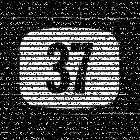 The United States Federal Communications Commission places a ten-year hold on television station licenses for UHF channel 37. Channel 37’s bandwidth, in the 608-614 megahertz range, is vital to the burgeoning science of radio astronomy. The FCC immediately sets about reallocating channels on the UHF dial for 18 television stations across America, which had previously been allocated channel 37 on their licenses. One month later, the ban on broadcasting in that part of the spectrum is made global; no television station in the United States, Mexico, Canada, and several other countries will ever occupy those frequencies. When the ban comes up for review again in 1974, it will be made permanent, though a petition from radio astronomers to set aside channel 36 at that time will be denied.
The United States Federal Communications Commission places a ten-year hold on television station licenses for UHF channel 37. Channel 37’s bandwidth, in the 608-614 megahertz range, is vital to the burgeoning science of radio astronomy. The FCC immediately sets about reallocating channels on the UHF dial for 18 television stations across America, which had previously been allocated channel 37 on their licenses. One month later, the ban on broadcasting in that part of the spectrum is made global; no television station in the United States, Mexico, Canada, and several other countries will ever occupy those frequencies. When the ban comes up for review again in 1974, it will be made permanent, though a petition from radio astronomers to set aside channel 36 at that time will be denied.
Building Arecibo
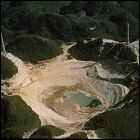 Proposed and designed by Cornell University, and funded by the Adavanced Research Projects Agency (ARPA), the Arecibo Ionospheric Research Center – a thousand-foot radar and radio telescope dish – begins construction in a natural limestone bowl south of Barrio Esparanza, Arecibo, Puerto Rico. Construction will take over three years, at a cost of nearly $10,000,000, with a steel feed receiver structure supported in mid-air over the parabolic dish by some five miles of steel cables. Facilities are constructed for scientists visiting the eventual facility, and additional facilities are constructed to shape aluminum into the mesh structure of the telescope dish on-site, a more economical approach than having those parts of the telescope shipped in from outside. Though conceived and pitched as a means of studying the ionosphere, with possible defense applications such as missile detection, the Arecibo facility will makes its best known contributions to astronomy after it opens.
Proposed and designed by Cornell University, and funded by the Adavanced Research Projects Agency (ARPA), the Arecibo Ionospheric Research Center – a thousand-foot radar and radio telescope dish – begins construction in a natural limestone bowl south of Barrio Esparanza, Arecibo, Puerto Rico. Construction will take over three years, at a cost of nearly $10,000,000, with a steel feed receiver structure supported in mid-air over the parabolic dish by some five miles of steel cables. Facilities are constructed for scientists visiting the eventual facility, and additional facilities are constructed to shape aluminum into the mesh structure of the telescope dish on-site, a more economical approach than having those parts of the telescope shipped in from outside. Though conceived and pitched as a means of studying the ionosphere, with possible defense applications such as missile detection, the Arecibo facility will makes its best known contributions to astronomy after it opens.
The Thousand Foot Radio Telescope
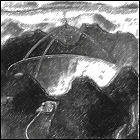 After months of lobbying the U.S. Air Force and the Advanced Research Projects Agency (ARPA) for help in funding a large-aperture radar/radio telescope dish for studies of Earth’s ionosphere and the space that lies beyond, Cornell University’s Bill Gordon publishes a report in the journal of the School of Electrical Engineering. Gordon’s report, setting out the basic parameters for the project, includes a reflector dish diameter of one thousand feet – a daunting prospect from a structural engineering perspective. Sites in Texas and upstate New York are considered before a natural limestone “bowl” south of the city of Arecibo, Puerto Rico emerges as a promising candidate site.
After months of lobbying the U.S. Air Force and the Advanced Research Projects Agency (ARPA) for help in funding a large-aperture radar/radio telescope dish for studies of Earth’s ionosphere and the space that lies beyond, Cornell University’s Bill Gordon publishes a report in the journal of the School of Electrical Engineering. Gordon’s report, setting out the basic parameters for the project, includes a reflector dish diameter of one thousand feet – a daunting prospect from a structural engineering perspective. Sites in Texas and upstate New York are considered before a natural limestone “bowl” south of the city of Arecibo, Puerto Rico emerges as a promising candidate site.
Ananke
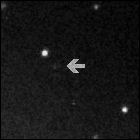 Using a telescope at Mount Wilson Observatory, astronomer Seth Nicholson discovers Ananke, a tiny moon of Jupiter orbiting the huge planet at an average distance of 21 million miles and at a high inclination relative to Jupiter’s equator. Ananke is most likely a captured asteroid or the remnant of a captured asteroid, and other small Jovian moons in the same orbit may be other pieces of the captured (and shredded) body. Ananke is the first Jovian moon discovered in nearly two decades, and it will be over two more decades before another is found.
Using a telescope at Mount Wilson Observatory, astronomer Seth Nicholson discovers Ananke, a tiny moon of Jupiter orbiting the huge planet at an average distance of 21 million miles and at a high inclination relative to Jupiter’s equator. Ananke is most likely a captured asteroid or the remnant of a captured asteroid, and other small Jovian moons in the same orbit may be other pieces of the captured (and shredded) body. Ananke is the first Jovian moon discovered in nearly two decades, and it will be over two more decades before another is found.
The Upper Atmosphere Research Panel
 The first meeting of the Upper Atmosphere Research Panel, known more informally as the V2 Panel, is held, comprised of researchers from various universities, industry, and the military, to decide on peaceful uses for the nearly 80 rockets’ worth of German V2 rocket hardware seized in Germany at the end of World War II. The technology of the rockets themselves will be studied, while payloads are proposed to study the properties of Earth’s upper atmosphere, radiation received from the sun, and the environment of space itself. Also of key importance will be reverse-engineering the V2 to aid in the design of American-made sounding rockets. Eventually the German scientists and engineers who were taken into custody with the captured hardware will be brought to the U.S. to continue their research.
The first meeting of the Upper Atmosphere Research Panel, known more informally as the V2 Panel, is held, comprised of researchers from various universities, industry, and the military, to decide on peaceful uses for the nearly 80 rockets’ worth of German V2 rocket hardware seized in Germany at the end of World War II. The technology of the rockets themselves will be studied, while payloads are proposed to study the properties of Earth’s upper atmosphere, radiation received from the sun, and the environment of space itself. Also of key importance will be reverse-engineering the V2 to aid in the design of American-made sounding rockets. Eventually the German scientists and engineers who were taken into custody with the captured hardware will be brought to the U.S. to continue their research.